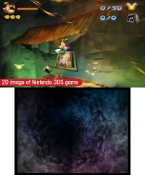
Alright, let’s address the elephant in the room: Rayman 3D is a cheap cash-in port of the Dreamcast version of Rayman 2. No, the game has not been enhanced in any meaningful way other than the addition of stereoscopic 3D - and no, it doesn’t in any way actually enhance the gameplay. Yes, at times, I even encountered a few instances where the game completely froze up, thus forcing me to hard reset my 3DS. All of this aside, Rayman 3D is still an enjoyable experience - one that has lost some of its luster over time. Thanks to the circle pad on the 3DS, the game controls like a dream, and the 3D, while nothing significant, adds some nice visual flair, giving the game a bit of extra charm. All things considered, this release of Rayman 2 is the definitive one.

At the time of its original release, Rayman 2 was a phenomenal game. It provided some rock solid platforming gameplay, a unique cast of characters, and a fittingly odd world that encouraged exploration and replay. While the game has started to show its age, it’s still a pioneer of combining disparate forms of gameplay into a singular coherent experience.
Thinking back on my time with the game (back on the N64), the platforming was the only mechanism that really stood out for me. However, after playing through it once again, it’s absolutely stunning just how many different styles of gameplay are explored throughout Rayman’s adventure.

Rayman’s core abilities allow him to accomplish a variety of tasks, aside from just running and jumping. He’s able to twirl his hair like a helicopter to stay afloat while slowly drifting downward. This ability is also used in conjunction with air streams that help keep Rayman afloat. This is similar in many ways to the hang gliding portions found in Pilotwings. Eventually, players will be able to propel themselves upward, which adds a new dimension to that mechanic.
He can also use his powers to throw magical orbs at enemies, providing for third-person shooter-like gameplay. This ability allows him to also swing from special ring lums, which plays into the game’s platforming elements, and while riding a giant plum, Rayman can use the force from throwing the orb to propel the plum like a makeshift boat.

On top of these abilities, players can pick items up and throw them to solve puzzles and attack enemies. Depending on the level, Rayman can also perform other tasks, like sliding down a long portion of a level all while avoiding impediments and keeping a high speed to stay ahead of impending doom. A rocket with legs (and a flying rocket!) can also be ridden, which always has forward momentum but can be steered and jumped, but will explode on impact with any given item in a level. Furthermore, certain levels exist where Rayman uses his orb shot to trail a boat, which resembles some of these other forced progression areas.
The result of intertwining these abilities and forcing players to take use of many of them to complete the levels is an extremely dynamic experience that proves entertaining from beginning to end. While enjoyable, the experience is still heavily rooted in collecting things, which might feel a bit archaic at this point. I’ve always loved the collection concept, but more modern iterations of platformers have reduced collection significantly to appeal to current tastes, thus dating this experience.

The game also puts a much stronger emphasis on replaying levels than I seemed to remember. Like many older games, branching paths are quite common, which is quite refreshing in this age of linearity; however, some branching paths will progress the level, thus closing off the area you previously came from. This means that choosing the wrong branching path will force you to replay the level to follow any rabbit holes you may have missed in your first traversal. With levels that can take as long as 30 minutes to complete, you’ll undoubtedly find yourself missing a number of items, which will result in at least one replay of the level to track down what you missed.
While this can be nightmarish for completionists, even players just making their way through the game will be affected by this design, as the core gameplay has instances where players must backtrack through past levels in order to complete tasks in a newer level. Combine this with some of the game’s ambiguity of what to do next and you can wind up rehashing more levels than desirable.

Though these are significant frustrations for completionists like me, I think most people will instead be frustrated by the barebones nature of this port. Rather than taking the opportunity to update this classic title that still largely stands the test of time, Ubisoft has just dumped it on (yet) another platform, devoid of any new features to make it more palatable for modern audiences. Updated graphics, new levels, or at least fixes to still outstanding bugs and glitches from the original release should’ve been included here.
With that in mind, only newcomers to Rayman 2 or those who want a copy on the go should bother with Rayman 3D. Everyone else will have already had their fill of the game and with nothing new to offer, fans can enjoy the game well enough on one of the many platforms they probably already own the game on.


















Comments